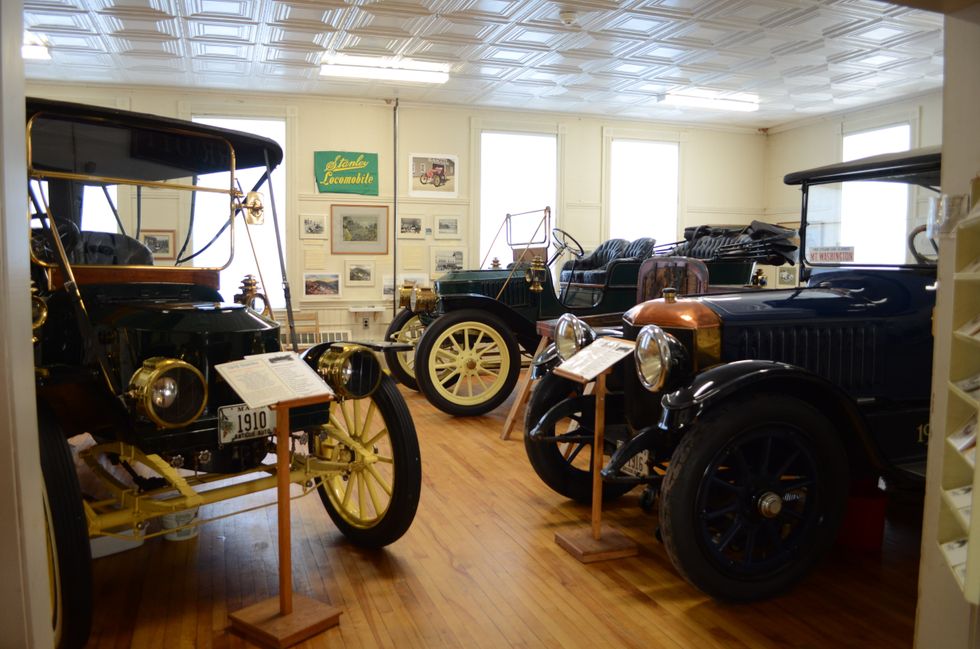
STEAM CARS AND MORE: A VISIT TO THE STANLEY MUSEUM
The more you learn about the Stanley twins, F.E. and F.O., the less surprising it becomes that they were responsible for designing the two-story clapboard building in their hometown of Kingfield, Maine, that now houses the museum that preserves their work for new generations. The Stanleys were true renaissance Yankees, and their talents extended far beyond creating the steam-powered automobiles we associate with them.
Theirs would have been remarkably full lives even if Francis Edgar hadn't become fascinated with steam propulsion in the late 1890s. Inspired and encouraged by their grandfather Liberty Stanley, the twins busied themselves with a series of inventions, starting with Freelan Oscar's design for a reasonably priced set of mechanical drawing tools for students, and F.E.’s creation of an atomizer for creating portraits — the first airbrush. By 1884, the brothers were working together in the field of photography, their Stanley Dry Plate Company eventually reaping sales of more than $1 million a year. One of their best-known creations was the grand Stanley Hotel in Estes Park, Colorado, built by F.O. as he sought a cure for his tuberculosis in the Rocky Mountain air.
Maine to Boston
The Stanley Museum, which opens for the 2024 season on April 1, tells all these stories, and more, in satisfying detail, with the help of many original artifacts. But it’s the steam-powered automobiles that take center stage in the museum's two main display areas.
A little history may be in order. Metropolitan Boston, where the brothers had relocated their dry-plate factory in 1890, was a hotbed of horseless carriage experimentation in the late 1890s, and it was F.E. who first caught the fever. Influenced by an early steam car demonstration (thought to be a French De Dion) at the nearby Brockton Fair, he built his first steam car in 1897, and made another for his brother the following year. Invited to bring a car to Boston's first automotive show at Charles River Park in 1898, F.E. covered a mile in 2 minutes and 11 seconds, an unofficial world record, and was the only entrant to make it to the top of the artificial hill climb in one go. Within two weeks, more than 100 potential buyers had emerged.
Steam Wins Out Over Photography
The twins set up shop at a former bicycle factory in Watertown, Massachusetts. They were soon approached by John B. Walker, the publisher of Cosmopolitan magazine, who wanted to buy them out. Uninterested in selling, the brothers set a ridiculously high price tag of $250,000 on the business — and were amazed when Walker agreed. Walker and his financial partner, A.L. Barber, soon parted ways, with Barber using the Stanley patents to create the Locomobile.
In 1902, the Stanley twins returned to car manufacturing, with an improved design modified to avoid patent issues. By the beginning of 1904, they had sold the Stanley Dry Plate Company to George Eastman, the founder of Kodak, and turned their focus solely on the car business. The company's reputation grew through competition, with Fred Marriott setting a world record 127.66-mph pass on Florida's Ormond Beach — now Daytona Beach — in 1906.
When Did Stanley Stop Making Steamers?
The Stanley Motor Carriage Co. had its best year in 1907, with 775 vehicles sold. From there, a number of factors conspired against the steamers. Marriott's attempt to break his own record in 1907 resulted in a crash; though the driver recovered, the brothers agreed that chasing world records posed too great a risk, which put a damper on further steam technology research and development. Competition with rival steam car manufacturers allowed internal combustion cars to make headway unchecked. Steam cars began to be excluded from racing events, while the steamer's natural disadvantages against the gasoline car — including a 45-minute start-up time from cold — dragged it down in the market. The widespread adoption of the self-starter was the knock-out blow.
F.E. and F.O. refinanced the company in 1917 and put its management in the hands of their sons-in-law and a nephew. The company was reorganized again in 1924 and moved to Allentown, Pennsylvania, where it struggled along for another two years. F.E. wasn't around to see the end; in 1918, he was killed in a car crash north of Boston, where he had been headed for a business meeting.
How Far Could a Stanley Go on a Gallon of Water?
At the museum, you'll find four Stanleys on display, three that are part of the permanent collection and one that's on long-term loan. When we visited, there was also an early Locomobile steam car in mid-restoration, as well as the wooden chassis of another Stanley showing construction techniques.
If you're curious about what makes a Stanley go, there are displays that make it all clear, including a steam engine and a boiler and burner unit that's been disassembled and mounted to offer a 3-D exploded view. Displays answer commonly-asked questions — for instance, it takes about 30 to 45 minutes to build up enough steam pressure from cold to drive; a Stanley can travel one mile per gallon of water (or 20 to 30 miles before a refill is needed), and eight to 10 miles on a gallon of kerosene; top speed varies from 25 to 75 mph, depending on the model; comfortable cruising speeds range from 25 to 50 mph.
Somewhere between 10,000 and 11,000 Stanleys were produced between 1897 and 1924, and Debbie Smith, executive director of the museum, estimates that 500 to 600 are still in existence, many as static displays in museums. At the Stanley Museum, the cars are kept in running condition by the “steam team,” and get driven out to participate in parades, tours, and other events where the public can appreciate them.
The Museum Building is an Artifact, Too
The building that houses all this history is a Stanley creation, too. The brothers designed the building as a school, and when funds ran short, they donated the money needed for its completion in 1903. Closed as a school in 1979, the building was going to be torn down for additional parking for the adjacent town hall until a group of Stanley enthusiasts persuaded town leaders to lease the building to them for $1 a year. The museum opened its doors to the public in 1981.
The museum is seasonal, closing at the end of December and reopening on April 1. (Before planning a visit, be sure to check the museum's website for the current schedule.) Debbie says that 600 to 800 people visit each year, with September and October being the most popular months, thanks to the brilliant foliage that brings visitors to the Sugarloaf Mountain region. “We're really off the beaten path, unless you're going to Sugarloaf,” she says. “It almost has to be a destination.”
'A Gem They Didn't Know About'
“What I tell people is that they can plan on probably an hour tour. It can be more, it can be less,” Debbie says. “You have to read your visitors to figure out what their interests are. We've had people that will be here at 11 o'clock and stay until 4, and sometimes come back the next day. We have other people that will go through in 15 or 20 minutes — they're only interested in a few things. But one of the most common comments, when they get in here and hear the stories, is that it's a gem that they didn't know about — there's so much more to the Stanley story than just the cars.”
What's a Stanley Worth?
When you do visit, keep in mind that steam car enthusiasm can be highly contagious. Debbie and her husband, Mark, fell under the spell of steam cars several years ago, after Mark saw a Stanley on display at the annual fair in nearby Farmington, and announced to Debbie that they needed to sell the 1935 Ford they had restored in order to buy one of their own. “The first steam car we bought for $35,000. That was in 1998, 1999. I was a teacher, and my husband worked at a garage. That was so much money! It was crazy. But they've increased in value since then,” Debbie says.
“People will ask, ‘What is a Stanley worth?’,” she adds. “And I say it's in the eye of the beholder.”
For more information about the Stanley Museum, including hours, cost of admission, and membership, visit stanleymuseum.org.
2024-03-27T16:19:50Z dg43tfdfdgfd
